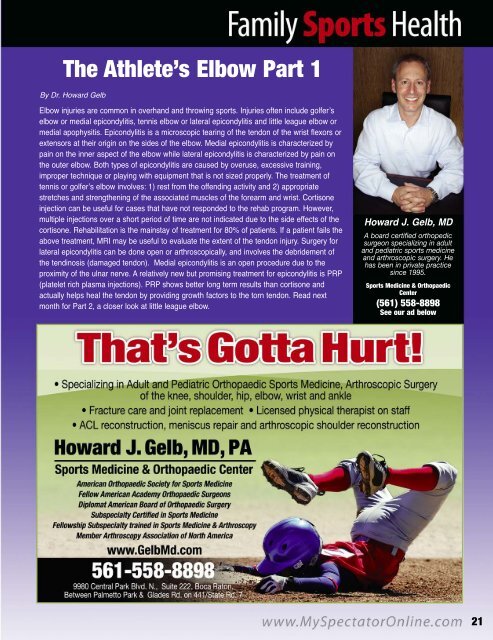Spectator Magazine November 2019
The number one Direct Mailed family resource magazine in Coral Springs and Parkland Florida Since 2002
The number one Direct Mailed family resource magazine in Coral Springs and Parkland Florida Since 2002
Create successful ePaper yourself
Turn your PDF publications into a flip-book with our unique Google optimized e-Paper software.
The Athlete’s Elbow Part 1<br />
By Dr. Howard Gelb<br />
Elbow injuries are common in overhand and throwing sports. Injuries often include golfer’s<br />
elbow or medial epicondylitis, tennis elbow or lateral epicondylitis and little league elbow or<br />
medial apophysitis. Epicondylitis is a microscopic tearing of the tendon of the wrist flexors or<br />
extensors at their origin on the sides of the elbow. Medial epicondylitis is characterized by<br />
pain on the inner aspect of the elbow while lateral epicondylitis is characterized by pain on<br />
the outer elbow. Both types of epicondylitis are caused by overuse, excessive training,<br />
improper technique or playing with equipment that is not sized properly. The treatment of<br />
tennis or golfer’s elbow involves: 1) rest from the offending activity and 2) appropriate<br />
stretches and strengthening of the associated muscles of the forearm and wrist. Cortisone<br />
injection can be useful for cases that have not responded to the rehab program. However,<br />
multiple injections over a short period of time are not indicated due to the side effects of the<br />
cortisone. Rehabilitation is the mainstay of treatment for 80% of patients. If a patient fails the<br />
above treatment, MRI may be useful to evaluate the extent of the tendon injury. Surgery for<br />
lateral epicondylitis can be done open or arthroscopically, and involves the debridement of<br />
the tendinosis (damaged tendon). Medial epicondylitis is an open procedure due to the<br />
proximity of the ulnar nerve. A relatively new but promising treatment for epicondylitis is PRP<br />
(platelet rich plasma injections). PRP shows better long term results than cortisone and<br />
actually helps heal the tendon by providing growth factors to the torn tendon. Read next<br />
month for Part 2, a closer look at little league elbow.<br />
Howard J. Gelb, MD<br />
A board certified orthopedic<br />
surgeon specializing in adult<br />
and pediatric sports medicine<br />
and arthroscopic surgery. He<br />
has been in private practice<br />
since 1995.<br />
Sports Medicine & Orthopaedic<br />
Center<br />
(561) 558-8898<br />
See our ad below<br />
21

















